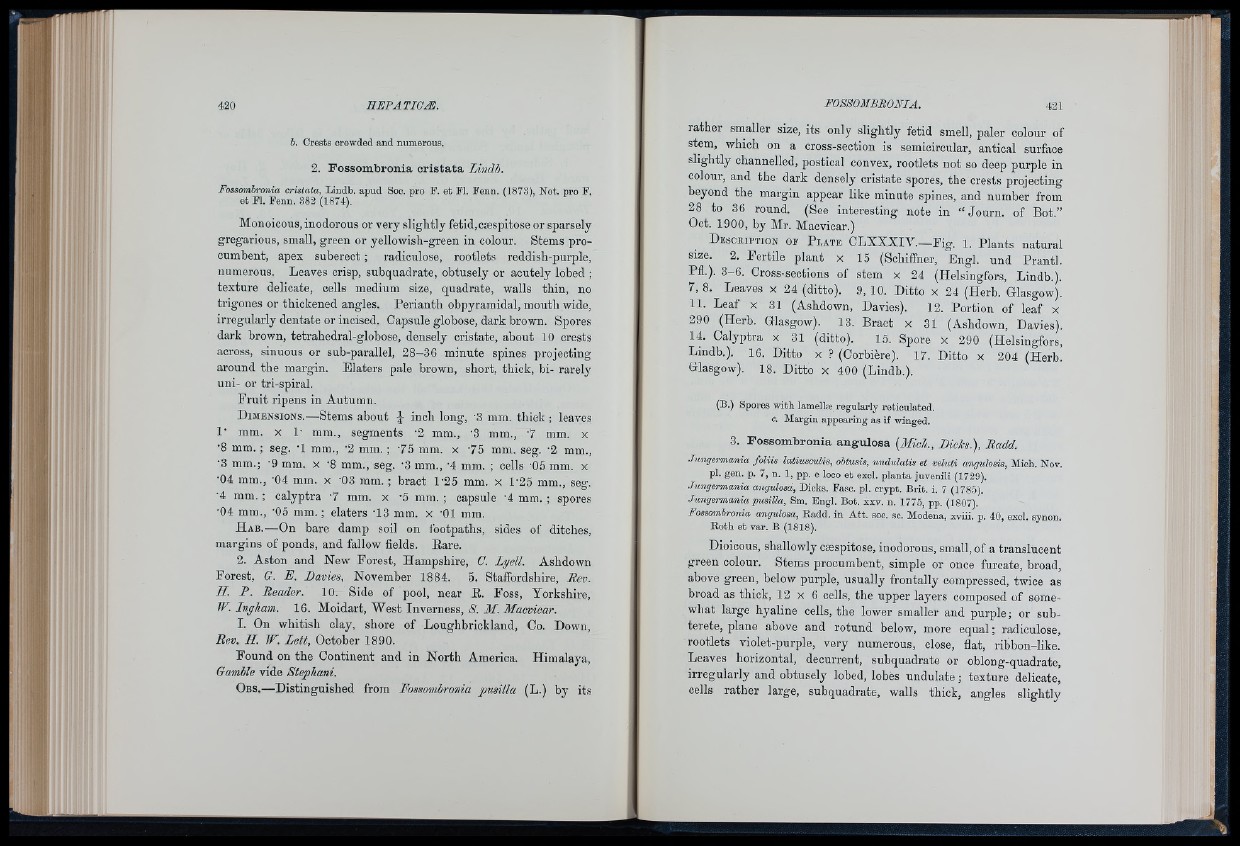
1 1 j i:
I ■.2ii
b. Crests crowded and numerous.
■0 F .
2. Fossombronia cristata Lindh.
Fossomhronia cristata, Lindb. apud Soc. pro F. e t Fl. Fenn. (1873), Not. pn
e t Fl. Fenn. 382 (1874).
Monoicous, inodorous or very slightly fetid,cæspitose or sparsely
gregarious, small, green or yellowish-green in colour. Stems procumbent,
apex suberect ; radiculose, rootlets reddish-purple,
numerous. Leaves crisp, subquadrate, obtusely or acutely lobed ;
texture delicate, cells medium size, quadrate, walls thin, no
trigones or thickened angles. Perianth obpyramidal, mouth wide,
irregularly dentate or incised. Capsule globose, dark brown. Spores
dark brown, tetrahedral-globose, densely cristate, about 10 crests
across, sinuous or sub-parallel, 28-36 minute spines projecting
around the margin. Elaters pale brown, short, thick, hi- rarely
uni- or tri-spiral.
Fruit ripens in Autumn.
D imens ions.— Stems about J inch long, '3 mm. thick ; leaves
!• mm. X 1- mm., segments ‘2 mm., ‘3 mm., 7 mm. x
•8 mm. ; seg. 7 mm., '2 mm. ; 75 mm. x 75 mm. seg. ’2 mm.,
•3 mm.; -9 mm. x ‘8 mm., seg. '3 mm., '4 mm. ; cells ’05 mm. x
•04 mm., -04 mm. x '03 mm. ; bract 1’25 mm. x 1'25 mm., seg.
■4 mm. ; calyptra 7 mm. x -5 mm. ; capsule '4 mm. ; spores
■04 mm., ^05 mm. ; elaters ■IS mm. x ■Ol mm.
H ab.— On bare damp soil on footpaths, sides of ditches,
margins of ponds, and fallow fields, Eare.
2. Aston and New Forest, Hampshire, C. Ljyell. Ashdown
Forest, G. E. Davies, November 1884. 5. Staffordshire, Bev.
IL. P. Reader. 10. Side of pool, near E. Foss, Yorkshire,
W. Ingham. 16. Moidart, West Inverness, S. M. Macvicar.
I. On whitish clay, shore of Loughbrickland, Co. Down,
Rev. H. W. Lett, October 1890.
Found on the Continent and in North America, Himalaya,
Gamble vide Stephani.
Obs.—Distinguished from Fossombronia pusilla (L.) by its
rather smaller size, its only slightly fetid smell, paler colour of
stem, which on a oross-section is semicircular, antical surfiice
slightly channelled, postical convex, rootlets not so deep purple in
colour, and the dark densely cristate spores, the crests projecting
beyond the margin appear like minute spines, and number from
28 to 36 round. (See interesting note in “ Journ. of Bot.”
Oct. 1900, by Mr. Macvicar.)
D e sc rip tio n oe P l a t e CLXXXIV.—Fig. 1. Plants natural
size. 2. Fertile plant x 15 (Sohiffner, Engl, und Prantl.
PH.). 8-6. Cross-sections of stem x 24 (Helsingfors, Lindb.).
7, 8. Leaves x 24 (ditto). 9, 10. Ditto x 24 (Herb. Glasgow).
11. Leaf X 31 (Ashdown, Davies). 12. Portion of leaf x
290 (Herb. Glasgow). 13. Braot x 31 (Ashdown, Davies).
14. Calyptra x 31 (ditto). 15. Spore x 290 (Helsingfors,
Lindb.). 16. Ditto x ? (Corbière). 17. Ditto x 204 (Herb.
Glasgow). 18. Ditto x 400 (Lindb.).
(B.) Spores with lamellæ regularly reticulated.
0. Margin appearing as if winged.
3. Fossombronia angulosa (Mich., Dicks.), Radd.
Jungermania fo liis latiuscuUs, obtusis, nndulatis et velmti angulosis, Mich. Nov.
pi. gen. p. 7, n. 1, pp. e loco et exol. p lan ta juvenili (1729).
Jungermania angulosa, Dicks. Fasc. pi. crypt. B rit. i. 7 (1786).
Jungermania pusilla, Sm. Engl. Bot. xxv. n. 1775, pp. (1807).
Fossombronia angulosa, Eadd. in A tt. soc. sc. Modena, xviii. p. 10, excl. synon.
E o th et var. B (1818).
Dioicous, shallowly cæspitose, inodorous, small, of a translucent
green colour. Stems procumbent, simple or once furcate, broad,
above green, below purple, usually frontally compressed, twice as
broad as thick, 1 2 x 6 cells, the upper layers composed of somewhat
large hyaline cells, the lower smaller and purple; or sub-
terete, plane above and rotund below, more equal ; radiculose,
rootlets violet-purple, very numerous, close, flat, ribbon-like.
Leaves horizontal, decurrent, snbquadrate or ohlong-quadrate,
irregularly and obtusely lobed, lobes undulate ; texture delicate!
cells rather large, snbquadrate, walls thick, angles slightly